|
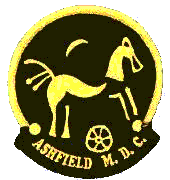
| |
JUST AN 'ORDINARY' DAY!
|
 |
|
PAUL WIGGINTON (aka Wiggo) and ANTHONY JAMES (aka Postie)
They are shown here holding some of the hoard of silver Roman
denarius found by both of them on a club search in September.
All are Roman imperial coins with one exception, a coin of Mark Antony
who died in 30B.C. The imperial coins date from 69 to 138A.D. that
would be the period between the building of the Fossway (A46) and
the death of Hadrian the wall builder.
The find spot was on the top of a high hill that commands a
spectacular view of the surrounding countryside, leading to the
speculation that the loss may have been a lost purse, possibly by a
lookout, and not a buried hoard. No pottery, coins or other
artefacts were discovered in the
vicinity.
Further details see below,
|
FIND OF THE MONTH AUGUST
|
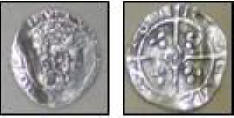 |
COIN:-
Henry V hammered silver penny.
1413 -
1422.
Found
by John Wardle. |
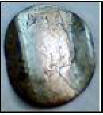 |
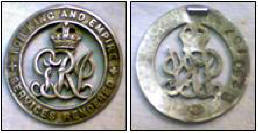 |
ARTEFACT:- William 111 silver love token. Joint.
Found by Mike Tindall.Silver War Badge.
Found by Dennis Brown. Joint. |
THE SILVER WAR BADGE
Dennis Brown was awarded the joint August ‘Find of the Month Award’
for his Silver War Badge found during a club search..
The badge was first authorised in 1916 and issued to all
military personnel who were discharged through sickness or wounds
contracted or received during the war, either at home or overseas.
It was worn on the lapel of civilian clothes.
The reason for this badge was to prevent men of military age,
out of uniform, being harassed by women attempting to give them a
‘white feather’ as a sign of cowardice. The ‘Organisation of the
White Feather’ was formed by Admiral Charles Fitzgerald at the start
of the First World War as a means of applying pressure on able
bodied men to enlist in the British Army.
The Silver War Badge was also known, erroneously, as the Silver
Wound Badge. It was circular in shape with the George V cipher
surrounded by the legend For King and Country - Services Rendered.
Each badge was numbered, the one found by Dennis has the number
B250157 on the back.
An interesting find that illustrates part of the scene in Britain
and the depth of public feeling during the First World War.
***
|
FIND OF THE MONTH
SEPTEMBER
COIN:- The award
was awarded to Antony James and Paul Wigginton for the hoard of
Roman denarius found on a club search. (Illustrated
below).
|
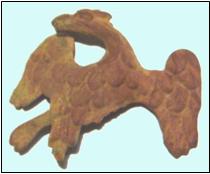 |
ARTEFACT:- Roman eagle mount.
Found by Jeff Oscroft.
A near identical mount is in Benet’s Artefacts second volume,
page171 number R09-0403.
Described as Mount (Eagle) 50mm. Spread wings with feathers
detailed. Mounted on a stem. Perhaps from a military standard. |
OTHER FINDS MADE SINCE THE LAST
NEWSLETTER
|

Edward1 long cross penny found by David Hallam. |
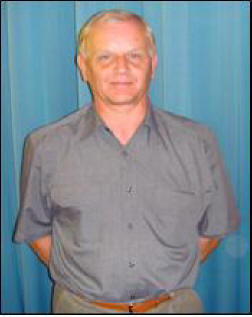
Alan Roberts |

Charles 1 silver half groat found by Alan Roberts.
This was the first hammered coin found by Alan who is a new
member of the club.
First of
many!
|
|
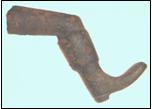
18th/19th., century pipe tamper in the design of a leg
wearing a riding boot. Found by Gerry Scothern.
See
Detector Finds 1 page six. |
SILVER THREE SHILLING BANK TOKEN
|
|
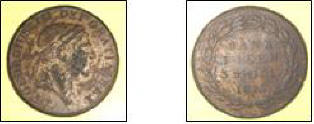 |
|
Dated 1815 and found by Tony Elliott. Issued by the Bank
of England between 1811 and 1816, they were struck in
silver with denominations of one shilling and sixpence
(7.5 grams) and three shillings (15 grams). The Bank's
name does not appear on the coins, just the legend `Bank
Token'.
They were issued because no halfcrowns had been
minted since 1751 and the supply of overstrikes had
proved to be inadequate. |
GOLD FOUND ON RALLY
|
|
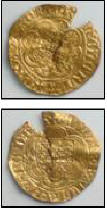 |
Dave Rhodes on his second signal at the recent
Market Rasen Rally found this Edward 111 gold noble,
pictured on the left. Unfortunately the coin was
damaged prior to Dave finding it. I wonder what his
first signal was, a Double leopard perhaps?
We do not have a picture of Dave at the Rally but,
on the right, we have one of him when he found this
superb Elizabeth 1 silver threepence dated 1574, on
a club search near Southwell.
|
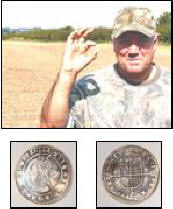 |
| |
|
|
'OILS' WELL THAT ENDS WELL!
|
|
The club was approached by a local farmer to
locate some obsolete oil pipes on a farm he had
just bought. The oil pipes were not reclaimed
after the oil company had dismantled its small
oil rigs known as ‘Nodding Donkeys’ which had
been vital during World War 2.
Normally the pipes were deeper in the ground than the plough would
reach and cultivation was unaffected. However
the drainage of the land left a lot to be
desired and the farmer decided to locate and
take out the pipes in order to break the sub
soil up and install new drains.
The fields in which the oil pipes were buried covered over one hundred
and fifty acres and no maps existed to indicate
where the pipes were. Another drawback was the
depth, between two and three feet deep.
Definitely all metal mode!
After a considerable time searching club members found a large number
of pipes, in length many hundreds of feet. The
pictures below show the work in progress 1. The
excavator exposing the pipes after they had been
located. 2. A pipe being extracted from the
ground. 3 Just a few of the pipes recovered. 4.
Mary Severn insisting on filling the hole. The
depth that the pipes were recovered from can be
judged by how deep in the trench Mary is
standing. |
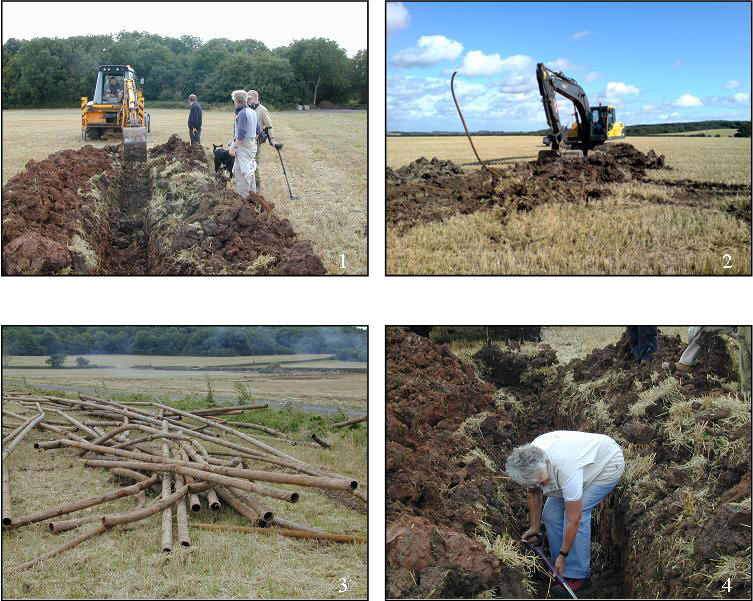 |
HANDS THAT DO DISHES?
|
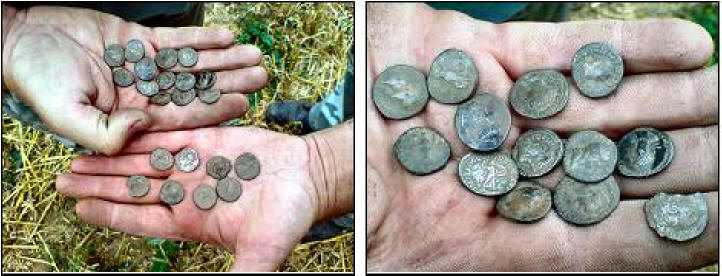 |
|
Paul
Wigginton and Anthony James holding their
hoard of silver denarii. |
part of the hoard found by Anthony
James.
|
 |
|
1. Hadrian
2.
Titus
3.
Trajan |
 |
|
4. Trajan
5.
Unknown
6. Domitian |
|
 |
7.
Hadrian
8.
Unknown
|
|
Of the 8 Roman denarii found by
Antony James 6 of them have been
provisionally identified. They
are:- |
|
Number of
coins
1
1.
2
2 |
Emperor
Titus
Domitian
Trajan
Hadrian |
Date of
reign
71 - 79 - 81A.D.
73 - 81—96A.D.
98 - 117A.D.
117 - 138A.D. |
| |
|
|
|
PART OF THE HOARD FOUND BY PAUL
WIGGINTON
|

1. Vespasian
2. Vespasian
3.
Vespasian
|
|
|

4. Trajan
5. Trajan
6.
Trajan |
|
|

7. Trajan
8 Trajan
9. Domitian |
|
|

10.
Domitian
11.
Hadrian
12. Sabina |
|
|
|

13. Mark Antony
14. Unknown |
|
Of the 14 Roman
denarii found by Paul Wigginton 13
of them have been provisionally
identified. They are:- |
|
Number of
coins |
Emperor |
Date of
reign |
| 1. |
Vespasian |
60 - 70A.D. |
| 2. |
Domitian |
73 - 81A.D. |
| 5. |
Trajan |
98 - 117A.D. |
| 1. |
Hadrian |
117 - 138A.D. |
| 1 |
Sabena
(Wife of Hadrian) |
117 - 137A.D. |
| 1 |
Mark
Antony |
30B.C. (Died) |
| The date of the
hoard is after 138A.D.. The coin
out of sequence is the one of
Mark Antony. This may have been
a good luck piece. |
AN
INTERESTING EXTRACT FROM THE
BRITISH ARCHAEOLOGICAL
SOCIETY 1850
|
|
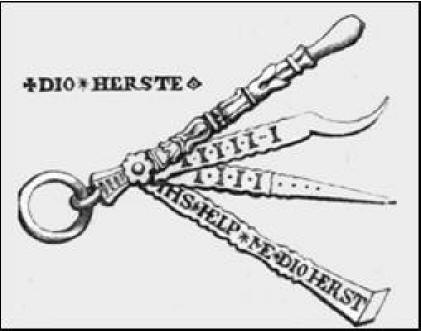 |
|
Mr. Lower forwarded the
following communication:—"I
send a drawing of a very
curious relic lately dug up
in the church-yard at
Alfriston, county of
Sussex. What name to give
it, I do not know, though
its uses are quite obvious.
It comprises an ear-pick, a
nail-picky a tooth-pick, and
a tongue-scraper; the turned
part of the last ingeniously
I
contrived to protect
the points of the other
three. When closed, this
little implement (which I
have delineated of the
actual size) might be
conveniently carried in
one's waistcoat pocket The
material is silver-gilt. It
was discovered at the depth
of three feet, in digging a
grave, on the site of an old
foot-path, where no
interment had taken place
for many years. As no motive
can be assigned for burying
such an article with a dead
body, I am disposed to
imagine that it must have
fallen from the person of a
bystander into an open grave
during a funeral.
On the inside of the tongue-scraper the
following legend is neatly
engraved:
ihs *
help *
me *
dio. herst. On the
corresponding face of the
ear-pick, the name only is
repeated,
dio *
herst. The mark of
contraction over the
ihs could not be
shown in my sketch.
In the parish register of Alfriston, is the
following entry, referring
to the original possessor of
this interesting relic:—
Buryalls A°. Dni. 1584.
Dennis Herst, buryed the
xiiij of ffebruarys.
The article is clearly of a
considerably earlier date,
and was probably
manufactured some thirty or
forty years before the
period of Herst's decease.
It is in the possession of
Mr. James Richardson, parish
clerk of Alfriston." |
|
BOOKS |
 |
HOOKED-CLASPS & EYES -
Brian Read
In this issue of our
newsletter I would like
to feature a book
‘Hooked-Clasps and Eyes’
by Brian Read that I was
lucky enough to win in a
recent Searcher magazine
competition. Many of you
will know the author
from his other books,
History Beneath Our
Feet, Metal Artefacts of
Antiquity and Metal
Buttons 900 BC - c.AD
1700, all firm
favourites with metal
detectorists.
The book covers, in
over 800 separate
descriptive entries with
images, small sharp or
blunt hooks known as,
clothing fasteners,
clothing hooks, dress
fasteners, dress hooks,
hooked fasteners, hooked
tags, hooks and eyes,
cloak fasteners, cloak
clasps, scarf hooks, hat
hooks, collar clasps,
nummular brooches,
havettes, toggle clasps
and sword belt fittings.
Available from
Portcullis Publishing
£19.95 £2 P &P.
|
|
THE FIRST
HOARDHUNTER |
 |
|
Postie and Wiggo
WITH THE FIRST
Minelab hoARDHUNTER |
|
BUSTS ON ROMAN
COINS THAT MAY
BE FOUND IN
BRITAIN (2) |
 |
OTHO A.D. 69
Marcus Salvius
Otho was born in
A.D. 32. He was
a favourite of
Nero who, in
A.D. 58,
appointed him
governor to
Lusitania in
order to seduce
his wife Poppaea.
After ten years
as governor he
supported Galba
in his revolt
however Galba
adopted Piso
instead of Otho.
Otho then had
himself
proclaimed
emperor and had
Galba and Piso
killed. He
defeated
Vitellius three
times but was
defeated in the
fourth battle
and committed
suicide by
stabbing
himself. He only
reigned for
ninety two days.
VITELLIUS
A.D. 69
Aulus Vitellius
was born in A.D.
15. He lived
most of his
young life at
Capri and was a
favourite with
Caligula,
Claudius and
Nero. In A.D. 69
he was sent by
Galba to
Germany. Soon
after he was
proclaimed
emperor by the
soldiers
defeating Otho
at the battle of
Bedriacum. His
gluttony and
vices were
phenomenal, in
the few months
he was in Rome
he spent
900,000,000
sesterces on
banquets. He was
killed by the
troops of
Vespasian and
his body was
thrown into the
Tiber. Reign was
from January to
December A.D.
69.
VESPASIAN A.D.
69 - 79
Titus
Flavius Sabinus
Vespasianus was
born in A.D. 9
the son of a tax
collector. He
soon rose in the
ranks of the
military and
commanded part
of the invasion
of Britain by
Claudius,
receiving the
‘Triumphalic
Ornamento’ for
his service. In
A.D. 60 Nero
chose him to
quell the
rebellion of the
Jews. A.D. 69
saw the legions
proclaim him
emperor and
later that year
he was accepted
by the senate.
He was a just
and able leader
and one of
Rome’s greatest
imperial
builders he died
in A.D. 79 and
was deified.
TITUS A.D. 71
- 79 Caesar, 79
- 81 Augustus.
Titus
Flavius
Vespasianus was
born in A.D. 40,
the oldest son
of Vespasian. He
put down the
Jewish rebellion
in A.D. 70. He
then returned to
Rome and
assisted his
father to
administer the
empire. In A.D.
79 he succeeded
his father to
the purple but
only reigned for
two years. His
short reign was
marred by two
disasters, the
eruption of
Mount Vesuvius
and destruction
of Pompeii and
Herculaneum and
the fire of
Rome. It was
rumoured that he
was poisoned by
Domitian but
this was never
proved.
DOMITIAN A.D. 73
- 81 Caesar, 81
- 96 Augustus.
Titus
Flavius
Domitianus was
the youngest son
of Vespasian he
was born in Rome
in A.D. 51. On
the death of his
brother, Titus,
he gained the
throne. At first
he ruled wisely
and acted to
control the
corruption of
city officials
and provincial
governors. He
put to death
three of the
Vestal Virgins,
for incest and
Cornelia, the
Chief Vestal,
for having
numerous lovers.
She was buried
alive and her
lovers beaten to
death. Domitian
was stabbed to
death as a
result of a plot
by his wife
Domitia, his
chamberlain and
the Praetorian
Prefect.
NERVA A.D. 96
– 98.
Marcus
Cocceius Nerva
was born in A.D.
30 he became an
influential
lawyer and was
consul with
Vespasian and
again in A.D. 90
with Domitian.
On the death of
Domitian he was
made emperor by
the Senate. He
ruled justly and
improved
conditions but
was unable to
command and
lacked
administrative
skills. The
situation became
serious and he
adopted a
military man,
Trajan, handing
to him full
powers. He lived
for just sixteen
months after
retirement and
died after
suffering a
fever. |
|
ASHFIELD
METAL
DETECTING
CLUB
DISPLAY
|
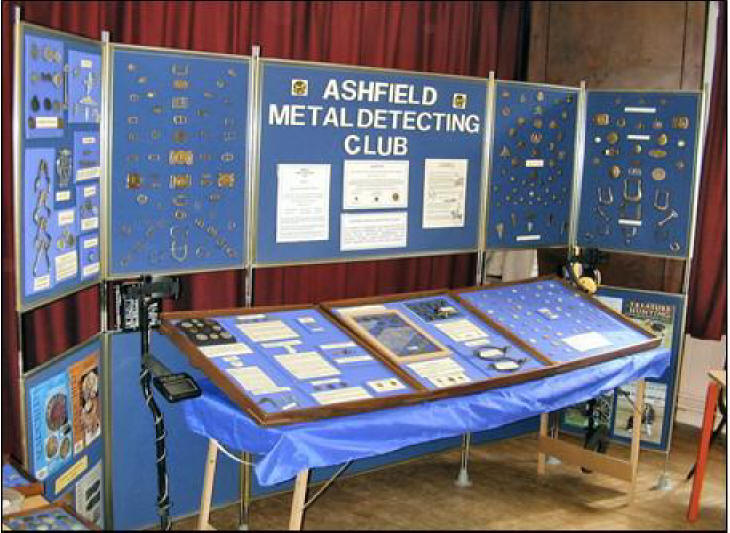 |
|
Part of a
display at a
talk given
to the
Mansfield
Over Fifties
Club by John
Gough on the
4th., of
September. |
|
